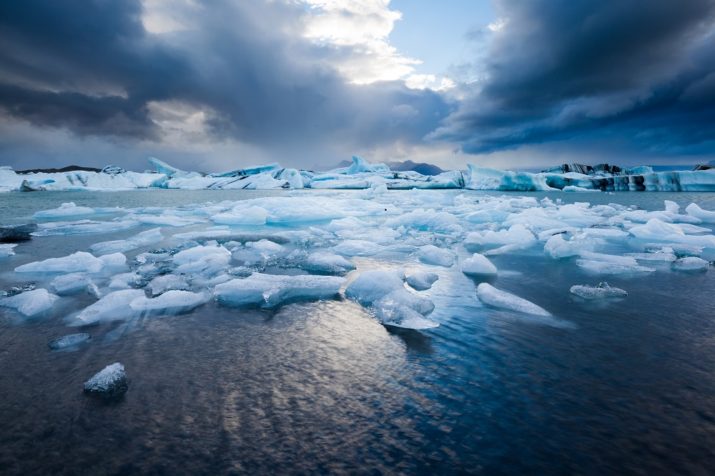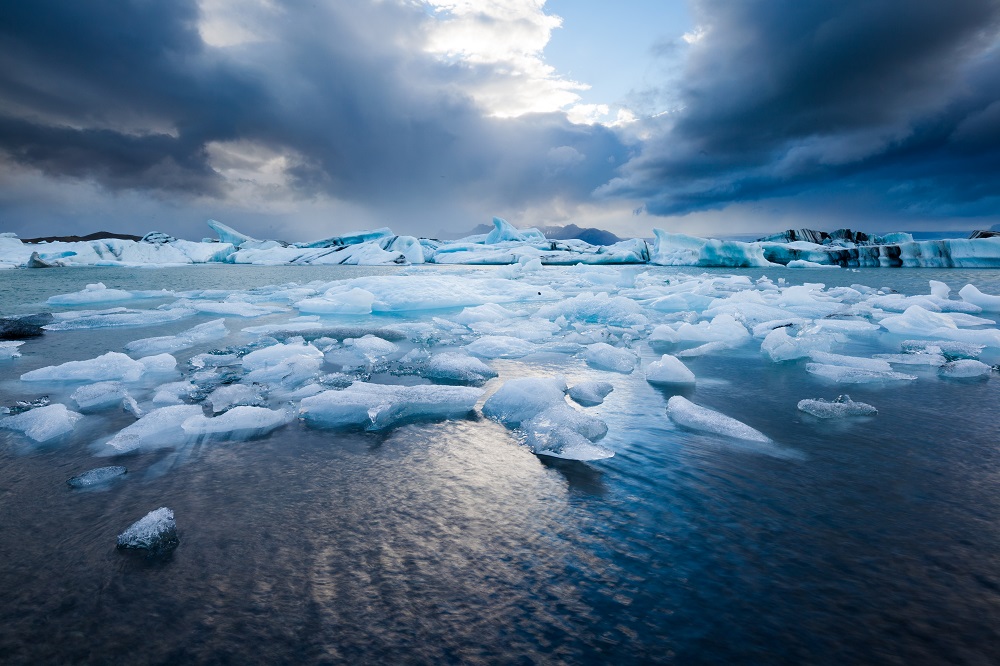

This is part of our special feature on Anxiety Culture.
The destabilizing impact of human activity on planetary systems compels a societal imperative to greatly reduce potentially irreversible consequences of personal and institutional decisions.[1] While we are beginning to remedy nine critical thresholds or planetary boundaries (including removing nitrogen from the atmosphere, reducing phosphorus flowing into the oceans, converting land cover to cropland, increasing consumption of freshwater and addressing biodiversity loss), scientists are concerned that some planetary thresholds, such as accelerating climate change, are already breached.[2]
Climatologists suggest that if we want to remain comfortably below the 2 degrees Celsius rise in average global temperature (which has occurred since the Industrial Revolution), we have to maintain less than 350 parts per million of carbon dioxide in the Earth’s atmosphere. Current estimates place us at more than 400 parts per million of CO2 in the atmosphere, which is contributing to extreme temperature variations, sea level rise, rapid ice melt, and the increasing frequency and duration of hurricanes, droughts, and wildfires.[3] This dynamic is threatening the relative stability and balance between planetary systems that is the hallmark of our Holocene era.[4] The Holocene period, which we have enjoyed for the past 11,500 years, is an ideal balance between “the right amount of carbon dioxide in the atmosphere, acidity in the oceans, coral in the sea, tropical forest cover along the equator and ice at the two poles to store water and reflect the sun’s rays to support human life and a steadily growing world population.”[5] This balance shaped our global weather patterns and determined our climate.
Accelerating disruptions of previously stable weather patterns across the globe has given rise to concerns over food insecurity and the risk of being displaced by a sudden, extreme weather event, which is 60 percent higher than it was 40 years ago.[6] The resulting migration trends, whether involuntary or not, are upending traditional notions of identity, citizenship, sovereignty and belonging.
Uncertainty, Anxiety and Fear Provoked by Accelerating Climate Change
Responses to this challenge range from the arbitrary assignment of responsibility and blame; to growing skepticism of scientific findings regarding accelerating climate change; to increasing awareness of our global “footprint” and the significance of the Paris Climate Accord (2016) in a movement to protect the integrity of our planetary systems. Regardless of where along a continuum we position ourselves (i.e., a complete focus on self and private interests at one end, to full public engagement and reciprocity at the other), the language or narrative we employ to make sense of accumulating research, competing ideas, opinions and/or fears of climate change can be influenced by personal and public discourse. Conversations at these levels can stoke not only uncertainty and fear in individuals and communities, but also generate a ubiquitous sort of anxiety, or a culture of anxiety if you will, which can have deleterious effects on our ability to think clearly and to consider the nuances of potential solutions that are themselves more dynamic than static.
If the symptoms of an anxiety culture include fears that may be shaped by the pulse of contemporary life and the struggle to understand the implications of accelerations in biodiversity loss, population growth, and globalization that, in turn, impact changing climate patterns, Steffen and his colleagues’ assertion that: “We are now living in a no-analogue world.” – suggests that “We have reached a point where many biophysical indicators have clearly moved beyond the bounds of Holocene variability.”[7] Given the growing consensus that we are entering or have already entered the next geologic era, called Anthropocene (Anthro = man; cene = new), which scientists believe will not be as appealing, nor as beneficial for human life as the Holocene, how can we engage these challenges without using rhetoric that distorts, produces social and political paralysis, malaise and a sense of disenfranchisement?
The Value of a Resilience Perspective
It appears that our ability to moderate anxiety over accelerations in climate change, may hinge on what we believe and how we perceive this issue. Cognitive scientists suggest the value of reframing our mental maps in efforts to process our fears and dilemmas more constructively and positively. Towards this end, the framework of resilience may resonate especially when we consider proof of concept examples, such as the emergence of a new field of inquiry and praxis called sustainability science; movement toward a post-carbon economy; and increasing attention to the environmental impact of individual and collective decisions. We can argue that these actions stem from understanding the scope and magnitude of the issue of climate change from a resilience perspective. In this context, resilience can be defined as “the ability of people, communities and institutions to prepare for, withstand, and bounce back more rapidly from acute shocks and chronic stresses.”[8]
Resilience in Action: The Netherlands
An example of this resilience framework in action can be seen in the Netherlands, which is surrounded on one end by the North Sea, into which the Rhine and the Meuse rivers flow from Belgium, France, and Germany. Much of the Netherlands sits below sea level and is gradually sinking. While climate change now brings the real possibility of more acute storms and rising tides to their front door, the Dutch have leveraged their expertise in handling centuries of floods and rising sea levels by creating design and construction firms that are in great demand by cities across the globe in need of their know-how and technology in water management.
This was not always the case, however. Over a hundred years ago, the North Sea flooded the Dutch coastline (in 1916), setting in motion a slew of protective construction that failed in 1953 when more than 1,800 people perished in a storm surge. The Dutch still refer to this tragedy as “the Disaster.” As recently as the 1990s, floods forced hundreds of thousands to evacuate and precipitated a major shift in Dutch thinking. Harold van Waveren, a senior government adviser for the Dutch government’s flood-prevention agency, indicated in a 2017 New York Times article that the floods were “a wake-up call to give back to the rivers some of the room we had taken.” He continued: “We can’t just keep building higher levees, because we will end up living behind 10-meter walls…We need to give the rivers more places to flow.”[9]
The Delta Works Project, a national effort to dam two major waterways, was launched. By 1997, the Maeslantkering, a giant storm surge barrier built near the mouth of the North Sea, was completed. Designed by the architect Wim Quist and considered one of modern Europe’s lesser-known engineering marvels, the Maeslantkering protects the entire port of Rotterdam, home to more than 600,000. The port also supports 90,000 jobs and another 90,000 workers whose businesses depend upon it. The Maeslantkering, the size of two tubular Eiffel Towers (though each arm/tube is twice as heavy), and resting horizontally on either side of the canal, is Rotterdam’s first line of defense. Although the Maeslantkering is yet to be used, it is frequently tested. When the gates close, the arms connect and lock. Water fills the tubes, which then sinks onto a concrete bed and forms a solid steel wall against the North Sea. The water pressure then shifts from the steel wall to ball joints (considered the world’s largest), which are rooted in the banks on both sides of the river. Water is drained from the tubes when the gates are reopened. To prevent cyber-attacks, the Dutch use a closed electronic system because if their computer systems are compromised and the gates cannot reopen, the Rhine and Meuse rivers cannot flow into the North Sea and would inundate Rotterdam faster than the North Sea could. The Dutch, who have redundant systems in place to prevent this kind of failure, are anticipating that sea levels will rise beyond current forecasts and are planning to add another two feet to the gates’ height.
Room for the River, an initiative that is reversing a centuries-old approach to taking territory from rivers and canals to build dams and dikes, has yielded the Eendragtspolder, a 22-acre collage of fields and canals that not only serve as a popular public space with bike paths and water sports, but also doubles as a reservoir for the Rotte River Basin when the nearby Rhine floods. Climate change models suggest that floods can happen every decade. Currently, rowing teams can be found practicing just outside of Rotterdam and, in summer 2017, the Eendragtspolder hosted the World Rowing Championships.
Implicit in the construction and use of the Maeslantkering and the Eendragtspolder is a philosophic outlook grounded in a resilience perspective that emphasizes not only mitigating the risk of disasters but also promoting an approach to environmental resiliency that is aligned with increasing social resiliency. That is, the Dutch understand that their capacity to reduce the risk of loss from climate change is connected with their ability to increase equity and inclusion, and improve housing, neighborhoods, sewers, and emergency services. And as noted above, they grasp the importance of leveraging cyber-resilient systems in maintaining the integrity of their bridges, sewers, and sea gates.
Rodin and her colleagues would argue that the Dutch are, in effect, reaping a resilience dividend because they are able to work with the water through specialized technologies and operating systems and translate those gains and benefits into public innovations that encourage the resiliency of their citizens.[10] That is, the resilience dividend benefits that have accrued to the Dutch comprise more than their ability to recover from a particular shock or withstand a stressor, to include a stream of net co-benefits derived from projects conceptualized, implemented, and iteratively evaluated from a resilience lens or perspective.
Rotterdam, for example, appears to be shedding a decades-old reputation of crime and filth as it evolves into a greener and more diverse city. Officials have supported the construction of facilities such as parking garages that also serve as emergency reservoirs and plazas with basketball courts, gardens, and fountains in under-resourced neighborhoods, that double as retention ponds. Similarly, and in consultation with residents, the city has repurposed harbors and industrial buildings along the waterfront for schools, housing, parks and to encourage entrepreneurs starting new businesses. There is also a flourishing business district in town with an international museum of photography that has a collection of 5.5 million photographic images and is in view of the iconic Erasmus bridge, or “The Swan,” designed by Dutch architect Ben van Berkel in 1996.
Officials also engage the community in identifying and implementing creative solutions in revitalizing neighborhoods. One solution involves developing rooftops to serve multiple purposes, including the curbing of water overflows. The Dakpark, located in a largely immigrant, low-income neighborhood bordering industrial waterfront, is a rooftop park integrated into a dike. Residents have reclaimed the neighborhood from crime and drug dealers and now enjoy a much-needed shopping center. Shop proprietors contribute funds to maintain the park, which extends from the roof down to the streets, forming a grassy hill that connects it with the neighborhood. Officials view the Dakpark as a model of resilient planning that links promoting social well-being vis-à-vis neighborhood improvement aligned with water management efforts. These efforts are not without their challenges. In the Spangen neighborhood nearby, a water plaza designed to capture floodwater, was vandalized. Over time, however, residents were persuaded of its value and have embraced it. A Turkish community operates a greenhouse near the water plaza and all involved are pleased with rising home values in the neighborhood.
Some critics cite the irony of a country branding itself as a hub of environmental ingenuity and urban renewal, when Rotterdam’s economy depends on the fossil fuel industry. Officials however, recognize the imperative of transitioning to a greener economy and see a future that include strategies to warm the greenhouses (that source agricultural products from the Netherlands), with heat from fuel-burning factories, to giant wind farms in the North Sea. There are also efforts underway to reduce truck traffic and carbon emissions, with floating dairy farms that supply the city with its own milk.
Significance of Cultivating a Resilience Perspective in Weathering Climate Change
The proactive approach utilized by the Netherlands can inform how we think through solutions, particularly when confronted with data from The Internal Displacement Monitoring Center, which indicates that an average of 24 million people per year since 2008, have been displaced by catastrophic weather disasters.[11] Migration experts and climate scientists estimate that these figures will increase dramatically as climate change exacerbates desert expansion, droughts, sea level rise, and storms. A March 2018 World Bank report projects, moreover, that by 2050, over 143 million people, or approximately 2.8 percent of the population in three of the world’s most vulnerable regions (sub-Saharan Africa, South Asia and Latin America, which together represent 55 percent of the developing world’s population), could be forced to migrate within their countries to flee the slow-onset impacts of climate change.[12] The authors of the report indicate that residents of the poorest and most climate- vulnerable areas will migrate to escape conditions of low water availability and crop productivity and from areas affected by rising sea levels and storm surges. Internal migration due to climate change is estimated to rise through 2050 and is projected to accelerate unless there is concrete action to significantly reduce greenhouse gas emissions and increase social services for vulnerable populations.
An analysis by Columbia University climate researchers suggests that developed countries will also be affected.[13] Missirian and Schlenker estimate that the projected rise in global temperatures can increase by 28 percent, the number of applications for asylum received by the European Union. This would amount to nearly 450,000 applications for asylum per year by 2100. This data suggests the crucial need for strategies to address this growing crisis and international agreement on the criteria for qualifying as a climate refugee.
In addition to considering some of the measures taken by the Netherlands, a U.N. task force established in the 2016 Paris Accord climate is expected to deliver recommendations that individual countries can take to prevent the displacement of residents who can become climate refugees. These measures include raising homes out of flood plains and funding programs to better equip farmers to weather droughts. Development agencies can also provide funding for climate adaptation programs, which can reduce displacement and provide people with the means to remain in their homes.
As evidenced by the Netherlands, planning from a resilience lens can mitigate the degree of destruction and devastation and build social resilience. This perspective can also be viewed as a key economic strategy with significant economic benefits and increased opportunity for residents. The significance of being proactive rather than reactive cannot be overestimated. There is much to do when viewed from a resilient perspective, and therein may lie potential insights for addressing growing anxiety regarding the impact of climate change.
Beatrice L. Bridglall is Dean of Humanities, Bergen Community College, and Fulbright Specialist in Higher Education.
Photo: Flatland near Jokulsarlon, South Iceland
References
[1] Will Steffen, Wendy Broadgate, and Lisa Deutsch, “The Trajectory of the Anthropocene: The Great Acceleration,” The Anthropocene Review 3 (2015b): 1–18.
[2] Will Steffen, Wendy Broadgate, and Lisa Deutsch, “The Trajectory of the Anthropocene: The Great Acceleration.
[3] Will Steffen, Wendy Broadgate, and Lisa Deutsch, “The Trajectory of the Anthropocene: The Great Acceleration.
[4] Johan Rockström and Mattias Klum; With Peter Miller, Big World, Small Planet: Abundance within Planetary Boundaries (New Haven: Yale University Press, 2015).
[5] Thomas Friedman, Thank You for Being late (New York: Farrar, Straus and Giroux, 2016).
[6] Internal Displacement Monitoring Center, 2017
[7] Will Steffen, Wendy Broadgate, and Lisa Deutsch, “The Trajectory of the Anthropocene: The Great Acceleration.
[8] Judith Rodin, The Resilience Dividend: Being Strong in a World Where Things Go Wrong (New York: Public Affairs, 2014).
[9] Michael Kimmelman, “Changing Climate, Changing Cities The Dutch Have Solutions to Rising Seas. The World Is Watching,” New York Times, June 5, 2017.
[10] Craig Bond, Aaron Strong, Nicholas Burger, Sarah Weilant, Uzaib Saya, and Anita Chandra, Resilience Dividend Valuation Model: Framework Development and Initial Case Studies, Santa Monica, CA: RAND Corporation, 2017. https://www.rand.org/pubs/research_reports/RR2129.html.
[11] Internal Displacement Monitoring Center, 2017
[12] Kanta Kumari Rigaud, Alex de Sherbinin, Bryan Jones, Jonas Bergmann, Viviane Clement, Kayly Ober, Jacob Schewe, Susana Adamo, Brent McCusker, Silke Heuser, Amelia Midgley, Groundswell: Preparing for Internal Climate Migration. Washington, D.C.: World Bank, 2018.
[13] Anouch Missirian and Wolfram Schlenker, “Asylum applications respond to temperature fluctuations,” Science 358, no 6370 (2017): 1610-1614.
Published on July 2, 2018.




